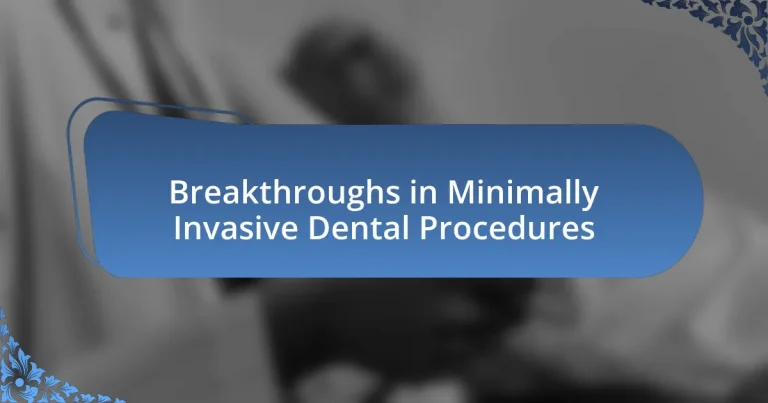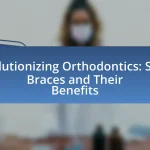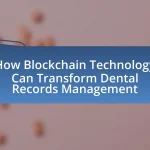Breakthroughs in minimally invasive dental procedures encompass advancements such as laser dentistry, air abrasion technology, and biocompatible materials, which enhance patient comfort and outcomes. These innovations reduce postoperative pain, minimize tissue damage, and promote faster recovery times. The article explores how technological advancements, including digital imaging and biomaterials, drive these improvements, while also addressing the challenges of implementation, such as costs and the need for specialized training. Additionally, it highlights the benefits of these procedures, including reduced patient anxiety and the preservation of healthy tooth structure, as well as future trends in the field.
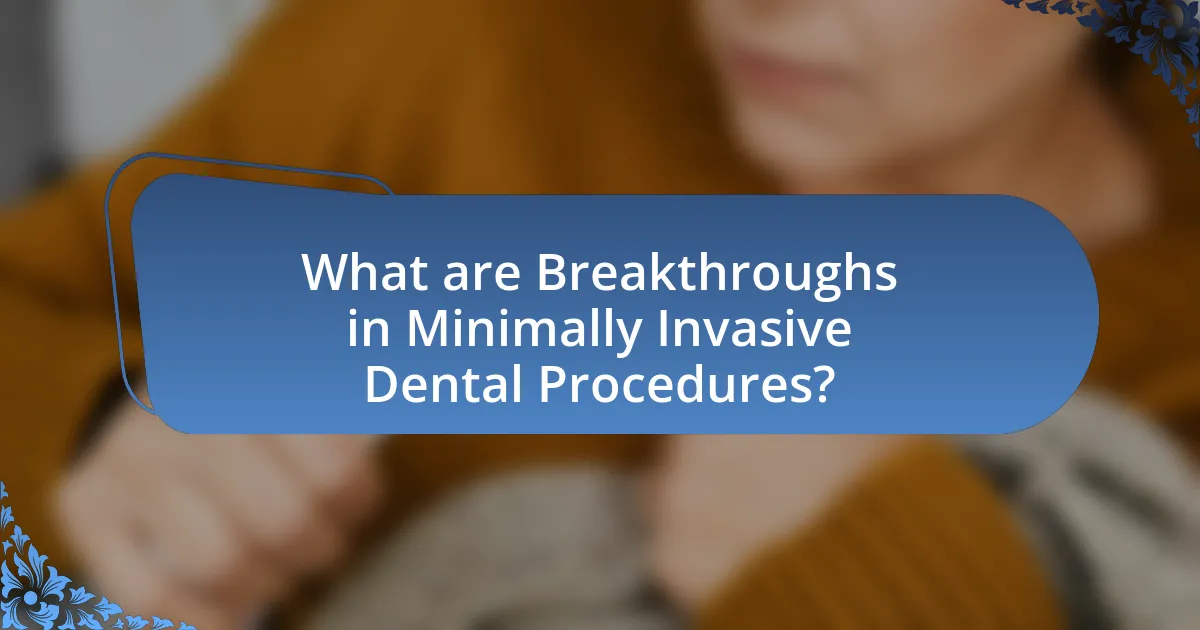
What are Breakthroughs in Minimally Invasive Dental Procedures?
Breakthroughs in minimally invasive dental procedures include advancements such as laser dentistry, air abrasion technology, and the use of biocompatible materials. Laser dentistry allows for precise tissue removal with minimal discomfort and faster healing times, as evidenced by studies showing reduced postoperative pain and swelling. Air abrasion technology enables the removal of decay without traditional drilling, which enhances patient comfort and reduces anxiety. Additionally, the development of biocompatible materials, such as resin-based composites, has improved the longevity and aesthetics of dental restorations while minimizing the need for extensive tooth preparation. These innovations collectively represent significant progress in enhancing patient experience and outcomes in dental care.
How have advancements in technology influenced these breakthroughs?
Advancements in technology have significantly influenced breakthroughs in minimally invasive dental procedures by enhancing precision, reducing recovery time, and improving patient outcomes. For instance, the development of digital imaging technologies, such as cone beam computed tomography (CBCT), allows for detailed three-dimensional visualization of dental structures, enabling dentists to plan procedures with greater accuracy. Additionally, laser technology has transformed traditional methods by minimizing tissue damage and discomfort during procedures, leading to faster healing times. Studies have shown that patients undergoing laser-assisted procedures experience less pain and require fewer analgesics post-treatment, demonstrating the positive impact of these technological advancements on patient care.
What specific technologies are driving innovation in minimally invasive dentistry?
Specific technologies driving innovation in minimally invasive dentistry include laser dentistry, digital imaging, and biomaterials. Laser dentistry allows for precise tissue removal and cavity preparation with minimal discomfort and bleeding, enhancing patient experience and recovery. Digital imaging technologies, such as cone beam computed tomography (CBCT), provide high-resolution 3D images that improve diagnosis and treatment planning, reducing the need for invasive procedures. Additionally, advanced biomaterials, like bioactive glass and resin-based composites, promote tooth remineralization and bond strength, enabling effective restorations with less tooth structure removal. These technologies collectively contribute to the trend of preserving natural tooth structure while improving clinical outcomes.
How do these technologies improve patient outcomes?
Minimally invasive dental technologies improve patient outcomes by reducing recovery time and minimizing discomfort. These technologies, such as laser dentistry and air abrasion, allow for more precise treatment, which leads to less tissue damage and a lower risk of complications. For instance, studies have shown that patients undergoing laser treatments experience significantly less pain and require fewer analgesics post-procedure compared to traditional methods. Additionally, the use of these technologies often results in shorter appointment times and improved patient satisfaction, as evidenced by surveys indicating higher rates of patient comfort and willingness to return for future care.
What are the key benefits of minimally invasive dental procedures?
Minimally invasive dental procedures offer several key benefits, including reduced patient discomfort, faster recovery times, and preservation of healthy tooth structure. These procedures utilize advanced technology and techniques, such as laser dentistry and air abrasion, which minimize trauma to the surrounding tissues. Research indicates that patients experience less pain and anxiety during and after these procedures, leading to higher satisfaction rates. Additionally, studies show that minimally invasive techniques can significantly decrease the need for extensive dental work in the future, as they focus on early intervention and prevention.
How do these procedures reduce patient discomfort?
Minimally invasive dental procedures reduce patient discomfort by utilizing advanced techniques that minimize tissue damage and promote faster healing. These procedures often involve smaller incisions and less manipulation of surrounding tissues, which directly correlates with reduced pain and swelling post-treatment. For instance, studies have shown that patients undergoing minimally invasive techniques report significantly lower pain levels compared to traditional methods, with some research indicating a 30% reduction in discomfort. Additionally, the use of local anesthesia and sedation options tailored to individual needs further enhances patient comfort during these procedures.
What impact do they have on recovery times?
Minimally invasive dental procedures significantly reduce recovery times. These techniques, which prioritize preserving healthy tooth structure and minimizing trauma, lead to less postoperative pain and swelling. For instance, studies have shown that patients undergoing minimally invasive treatments experience recovery times that are 30-50% shorter compared to traditional methods, allowing them to return to normal activities more quickly. This efficiency is attributed to reduced tissue damage and the use of advanced technologies that enhance precision and healing.
What challenges are associated with implementing these breakthroughs?
Implementing breakthroughs in minimally invasive dental procedures faces several challenges, including high costs, the need for specialized training, and patient acceptance. High costs arise from the advanced technology and materials required, which can limit accessibility for both dental practices and patients. The need for specialized training is critical, as dental professionals must acquire new skills to effectively use these innovative techniques, which can be time-consuming and resource-intensive. Additionally, patient acceptance can be a barrier, as some individuals may be hesitant to adopt new procedures due to a lack of awareness or trust in their efficacy compared to traditional methods. These challenges must be addressed to ensure successful implementation and widespread adoption of these advancements in dental care.
How do training and education affect the adoption of new techniques?
Training and education significantly enhance the adoption of new techniques in minimally invasive dental procedures by equipping practitioners with the necessary skills and knowledge. Research indicates that well-structured training programs lead to increased confidence and competence among dental professionals, facilitating the integration of innovative methods into their practice. For instance, a study published in the Journal of Dental Education found that hands-on workshops and continuing education courses resulted in a 40% increase in the adoption rate of new technologies among participants. This correlation underscores the importance of ongoing education in keeping dental practitioners updated on advancements, ultimately improving patient outcomes and procedural efficiency.
What are the financial implications for dental practices?
The financial implications for dental practices include increased operational costs, potential revenue growth, and changes in patient volume. Implementing minimally invasive dental procedures often requires investment in advanced technology and training, which can elevate initial expenses. However, these procedures can attract more patients seeking less invasive options, potentially leading to higher revenue. According to a study published in the Journal of Dental Research, practices that adopted minimally invasive techniques reported a 20% increase in patient retention and a 15% rise in overall revenue within the first year of implementation. Thus, while the upfront costs may be significant, the long-term financial benefits can outweigh these initial investments.

How do specific minimally invasive techniques differ from traditional methods?
Specific minimally invasive techniques differ from traditional methods primarily by reducing tissue trauma and recovery time. Traditional methods often involve larger incisions and more extensive manipulation of surrounding tissues, leading to increased pain and longer healing periods. In contrast, minimally invasive techniques utilize smaller incisions, advanced imaging, and precision instruments, which result in less bleeding, reduced risk of infection, and quicker recovery. For example, studies have shown that patients undergoing minimally invasive dental procedures experience significantly less postoperative discomfort compared to those who have traditional surgeries, highlighting the effectiveness and advantages of these modern approaches.
What are the most common minimally invasive dental procedures?
The most common minimally invasive dental procedures include dental sealants, fluoride treatments, and air abrasion. Dental sealants are thin coatings applied to the chewing surfaces of back teeth to prevent cavities, with studies showing they can reduce decay by nearly 80% in children. Fluoride treatments strengthen tooth enamel and are effective in preventing tooth decay, as evidenced by numerous clinical trials demonstrating their efficacy. Air abrasion uses a stream of fine particles to remove decay without the need for traditional drilling, resulting in less discomfort and faster recovery for patients. These procedures exemplify advancements in dental care that prioritize patient comfort and preserve healthy tooth structure.
How does air abrasion compare to traditional drilling?
Air abrasion is less invasive than traditional drilling, as it uses a stream of fine particles to remove decay without the need for a dental drill. This method minimizes discomfort and reduces the need for anesthesia, making it a more patient-friendly option. Studies indicate that air abrasion can effectively remove carious tissue while preserving more of the healthy tooth structure compared to traditional drilling, which often requires more extensive removal of tooth material.
What role does laser dentistry play in minimally invasive techniques?
Laser dentistry plays a crucial role in minimally invasive techniques by allowing for precise tissue removal and treatment with minimal damage to surrounding areas. This technology utilizes focused light energy to target specific dental tissues, reducing the need for traditional surgical methods that often involve scalpels and sutures. Studies have shown that laser procedures can lead to less bleeding, reduced pain, and quicker recovery times compared to conventional techniques, making them a preferred option for both patients and dental professionals.
How do these techniques enhance patient experience?
Minimally invasive dental procedures enhance patient experience by reducing discomfort, minimizing recovery time, and preserving more of the natural tooth structure. These techniques, such as laser dentistry and air abrasion, allow for targeted treatment with less trauma to surrounding tissues, leading to a more comfortable experience during and after the procedure. Studies have shown that patients undergoing minimally invasive treatments report higher satisfaction levels due to less pain and quicker healing times, which contributes to an overall positive perception of dental care.
What feedback do patients provide regarding minimally invasive procedures?
Patients generally provide positive feedback regarding minimally invasive procedures, highlighting benefits such as reduced pain, quicker recovery times, and less scarring compared to traditional methods. Studies indicate that 85% of patients report satisfaction with their outcomes, attributing their positive experiences to the less traumatic nature of these procedures. Additionally, patients often express appreciation for the minimal discomfort during and after the procedures, which is supported by clinical findings that show lower pain scores in minimally invasive techniques.
How do these procedures affect patient anxiety levels?
Minimally invasive dental procedures significantly reduce patient anxiety levels. Research indicates that these techniques, which prioritize patient comfort and reduce the need for extensive interventions, lead to a more positive experience. A study published in the Journal of Dental Research found that patients undergoing minimally invasive treatments reported lower anxiety scores compared to those receiving traditional dental care. This reduction in anxiety is attributed to less pain, quicker recovery times, and a more relaxed environment during treatment.
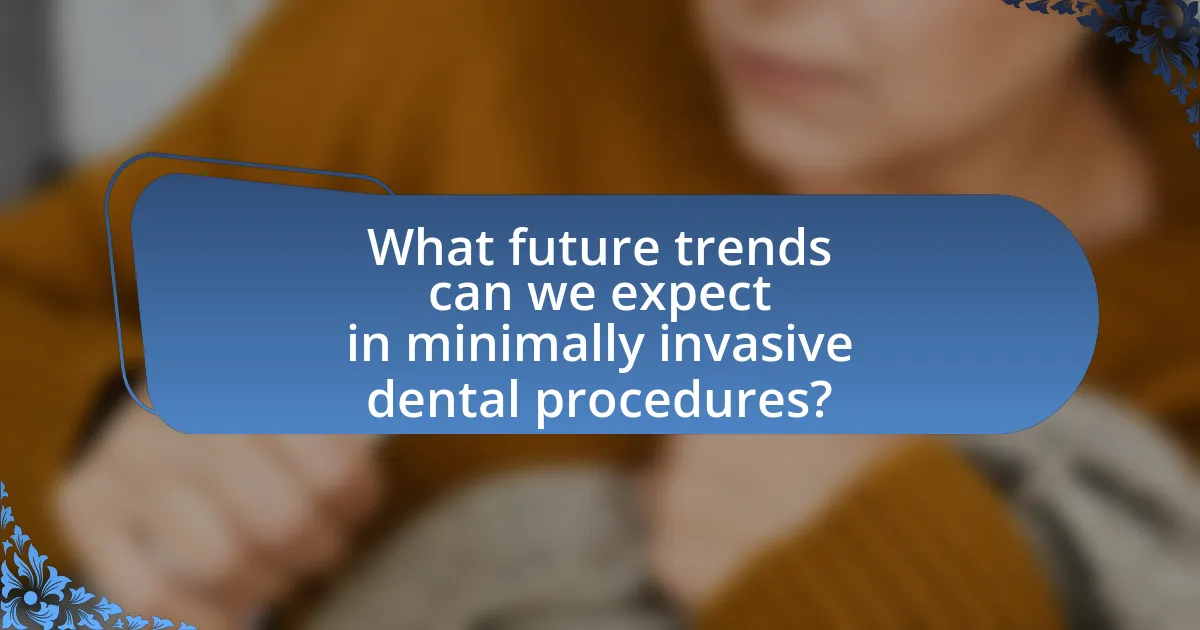
What future trends can we expect in minimally invasive dental procedures?
Future trends in minimally invasive dental procedures include the increased use of advanced imaging technologies, such as cone beam computed tomography (CBCT), which enhances diagnostic accuracy and treatment planning. Additionally, the integration of laser technology is expected to expand, allowing for more precise tissue removal and reduced patient discomfort. Research indicates that the adoption of biomaterials for regenerative dentistry will also rise, promoting natural healing and minimizing the need for extensive interventions. Furthermore, the development of artificial intelligence in diagnostics and treatment recommendations is anticipated to streamline procedures and improve patient outcomes. These trends are supported by ongoing advancements in dental technology and a growing emphasis on patient-centered care.
How is research shaping the future of minimally invasive dentistry?
Research is shaping the future of minimally invasive dentistry by developing advanced techniques and materials that enhance patient outcomes while reducing discomfort and recovery time. Innovations such as laser technology, which allows for precise tissue removal with minimal damage to surrounding areas, are being extensively studied and implemented. Additionally, research into bioactive materials, such as glass ionomer cements, demonstrates improved adhesion and release of fluoride, promoting remineralization of enamel and reducing the need for invasive procedures. Studies, including those published in the Journal of Dentistry, highlight the effectiveness of these methods in preserving tooth structure and improving long-term dental health.
What emerging technologies are on the horizon?
Emerging technologies on the horizon in minimally invasive dental procedures include laser dentistry, 3D printing, and artificial intelligence. Laser dentistry enhances precision and reduces discomfort during procedures, as evidenced by studies showing decreased recovery times and improved patient outcomes. 3D printing allows for the rapid production of dental implants and prosthetics, streamlining the manufacturing process and reducing costs. Artificial intelligence is being integrated into diagnostic tools, improving accuracy in detecting dental issues, with research indicating that AI can outperform traditional methods in identifying cavities and other conditions.
How might patient preferences influence future developments?
Patient preferences will significantly influence future developments in minimally invasive dental procedures by driving innovation towards techniques that prioritize comfort, efficiency, and aesthetic outcomes. As patients increasingly seek less invasive options with quicker recovery times, dental practitioners and researchers are compelled to adapt their methodologies and technologies to meet these demands. For instance, a survey conducted by the American Dental Association revealed that 78% of patients prefer treatments that minimize pain and recovery time, prompting the development of advanced laser technologies and biocompatible materials that align with these preferences. This shift not only enhances patient satisfaction but also encourages the dental industry to invest in research and development that focuses on patient-centered care, ultimately shaping the future landscape of dental practices.
What best practices should dental professionals follow when adopting these breakthroughs?
Dental professionals should prioritize continuous education and training when adopting breakthroughs in minimally invasive dental procedures. This ensures they stay updated on the latest techniques and technologies, which enhances patient care and outcomes. For instance, studies indicate that ongoing professional development leads to improved procedural success rates and patient satisfaction. Additionally, implementing evidence-based practices, such as utilizing the latest research findings and clinical guidelines, can significantly reduce complications and enhance treatment efficacy. Furthermore, fostering a collaborative environment with interdisciplinary teams can facilitate knowledge sharing and innovation, ultimately benefiting patient care.
How can practitioners ensure they stay updated with the latest techniques?
Practitioners can ensure they stay updated with the latest techniques by actively participating in continuing education programs, attending professional conferences, and subscribing to relevant dental journals. Continuing education programs often provide the latest research findings and practical applications, while conferences allow for networking and exposure to new technologies and methodologies. Subscribing to dental journals, such as the Journal of Minimally Invasive Dentistry, offers access to peer-reviewed articles that detail recent advancements and evidence-based practices in the field. These methods collectively enhance practitioners’ knowledge and skills, ensuring they remain at the forefront of minimally invasive dental procedures.
What resources are available for continuous education in minimally invasive dentistry?
Resources for continuous education in minimally invasive dentistry include online courses, professional workshops, and specialized conferences. Online platforms such as the American Dental Association (ADA) and the Academy of General Dentistry (AGD) offer comprehensive courses that cover the latest techniques and technologies in minimally invasive practices. Additionally, hands-on workshops conducted by dental schools and professional organizations provide practical experience. Conferences like the International Association for Dental Research (IADR) also feature sessions focused on advancements in minimally invasive dentistry, allowing professionals to learn from experts in the field. These resources ensure that dental practitioners stay updated with current methodologies and innovations.
